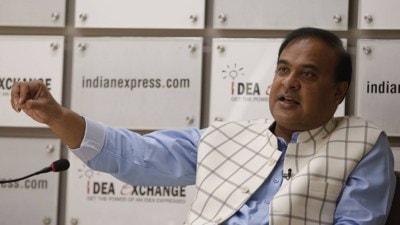Stay updated with the latest - Click here to follow us on Instagram
Figuring the Abstract
More than 350 abstracts trace the journey of the genre in India.
 Ram Kumar’s Ruins; an untitled acrylic-and-marker work by FN Souza.
Ram Kumar’s Ruins; an untitled acrylic-and-marker work by FN Souza.
Layers of dark browns and ochre envelope the ethereal white, like mountains that surround the snowcapped hills of the Himalayas. The outlines form the landscape — a work typical of the period when Ram Kumar had withdrawn from figurative and moved to more abstract depictions, where jagged lines and a colour palette would suffice to represent a place, from the pines of Shivalik to the ghats of Varanasi or the foothills of Himalayas. This 1972 canvas titled Ruins is on the back cover of the publication Indian Abstracts: An Absence of Form (DAG, Rs 5,000). It also occupies a central place in the accompanying show at the Capital’s Delhi Art Gallery.
Kumar belongs to the small group of Indian artists who abandoned figurative to adopt abstract, never to revert to the narrative mode. He had for company the likes of VS Gaitonde, Mehlli Gobhai and Nasreen Mohamedi. If Gaitonde was to discover his language in Zen philosophy and ancient calligraphy, Mohamedi found hers in the mathematical precision of spare lines that also expressed personal grief and turmoil. “It is odd that she should choose so unsparing a style to mark her emotional highs and lows,” writes Kishore Singh, head, publication and exhibition at Delhi Art Gallery (DAG).
Curator and art critic Meera Menezes challenges the popular belief that abstraction originated in the West in the 1900s. “Think of the rocks or cave walls dating from prehistoric times, such as the Eddakal Caves in Kerala or Ayers Rock in Australia. They are adorned with drawings of spiral forms, straight and meandering lines which attempted to fathom the mysteries of the universe,” says Menezes.
She classifies the abstract in India according to its characteristics. Comparison is made between Kumar’s planar abstraction and that of Surya Prakash’s works. Though both broke up the pictorial surface, the latter derived from machines and not nature.
The display has geometric abstractions — where natural organic forms were rejected for restricted pictorial elements — of SH Raza and GR Santosh. If Jeram Patel pursued abstract expressionism, with emphasis on gesture and lyrical possibilities of nature, the likes of Ganesh Haloi represented landscapes in abstract. Ambadas sought spiritual upliftment through his work, while others such as J Swaminathan incorporated visual elements of tantric art.
A separate segment celebrates the abstract in printmaking, from the times of Nandalal Bose and Benode Bihari Mukherjee to Lalu Prasad Shaw and Krishna Reddy. One wonders if there is any singular definition of abstract. Perhaps not.







